


|
|
|
|||||||||||||||
|
|
||||||||||||||||
|
|
|||
|
|
Valencia Cathedral of the Holy Chalice
The Cathedral of the Holy chalice is a Gothic Cathedral located in the old town at the centre of Valencia. It is known as “Saint Mary's Cathedral”, “The Basilica of the Assumption of Our Lady of Valencia” or just as "Valencia Cathedral". Built on the site that was previously a Roman temple, a Visigoth cathedral, and an 8th-century Mosque, it was several decades after the Christian conquest of the city (1238), before the cathedral was constructed, between 1252 and 1482. Construction is in the Gothic style, although it contains elements of early Romanesque, Renaissance, Baroque and Neoclassical. Originally the cathedral was dedicated to the Holy Saviour but was rededicated to the Blessed Virgin by James I (the Conqueror) who was King of Valencia (1238 – 1276). He would carry an image of the Virgin, which is now displayed in the sacristy. The octagonal Bell Tower, which is known as "Micalet" or "La Miguelete" named after its largest bell called Miguel, was constructed between 1381–1425. The Bell Tower is accessible to visitors who are able to climb the 207 steps to the top of the tower with good views across the city. It s also possible to see the bells on some occasions, although this isn't always possable. Originally this was separate from the main building but in 1459 the nave was extended joining the Tower with the Chapter House and the rest of the cathedral. This also resulted in the construction of the main entrance. In 1674 work began on the construction of the main chapel. During the Renaissance (15th-16th centuries), little work was done on the main structure, although work was carried out on the decorations in the Resurrection chapel and on one of the high altars. The façade of the main entrance was added at the beginning of the 18th century and restoration started in 1774, which converted the pointed Gothic arches to rounded arches. It also covered the Gothic columns with Corinthian pillars. The intention of the work was to give the building a neoclassical appearance. The work affected both structural and decorative features with elements being removed while others were concealed with stucco. There are a number of approaches to the cathedral which present different views. The approach in the photograph below shows the Cathedral entrance with the Door of the Apostles with the Dome Tower visible above the building and the Bell Tower on the right. 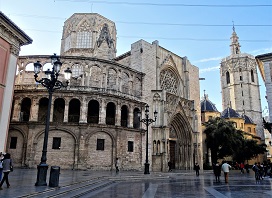 The first door to the cathedral was the Door of Arms and was named due to it being situated next to the House of Charity which was established in 1288. 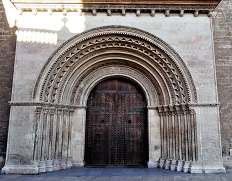 One of the other doors is the Door of the Apostles which consists of a series of flared arches with geometric decorations showing scenes from the Old Testament. 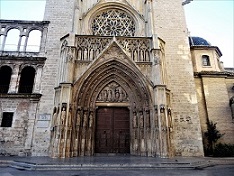 The Door of the Apostles is Gothic in style as indicated by the pointed arches. The statues which adorn the Apostle's doorway are copies, the originals of which are now in the museum. This was the main entrance to the Mosque and has a 14th century rose window positioned above it. This side of the building also contains the Galleries, a semi-circular triple arcaded wall of walkways in the Renaissance style which was built in the 16th century. The Main Entrance, the Iron Door, is located to the right of the belfry. Construction began in 1703, although this was interrupted by the War of the Spanish Succession (1701–1715). 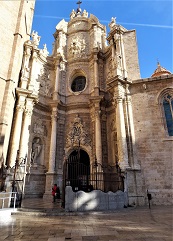 This was the 3rd door to be built: Baroque in design, the Iron Gate or Door was designed in 1703 by the German Konrad Rudolf as the main door of the cathedral in the Baroque style. It was designed to connect the Chapter House with the Bell Tower which previously had been separate buildings. It got its name due to the cast-iron fence that surrounds it The gate was damaged during the demolition of adjacent buildings in the 20th century to create the Plaza where the cathedral stands when the work caused the doors to distort. The cathedral interior is built with three naves, the central one with the Nave of the Gospel on the left and the Nave of the Epistle on the right. Originally these would have only reached to the choir of the present building. 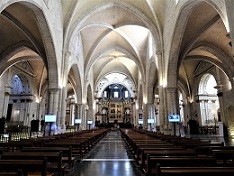 Three of the four sections of the naves and transepts were built in the first part of the 14th century which was when the crossing was completed and the construction of the crossing tower (cimbori or eight-sided dome) was also constructed. At the end of the Nave is the Presbytery with the Altar with a beautiful domed ceiling. 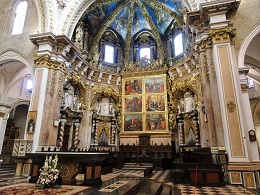 On the altar is the altarpiece which has a door in order to protect the statue of the Virgin Mary contained within. The dome ceiling, The Choir of Musician Angels, is one of the most important Renaissance paintings in Europe. Painted in the 1470s it was hidden by a shell of bricks until 2004 when it was discovered during restoration work and exposed.  Behind the Presbytery is the Ambulatory which contains a number of chapels, 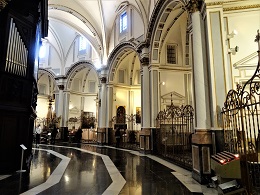 In the centre of the Ambulatory, just behind the altar, is the Chapel of the Resurrection. 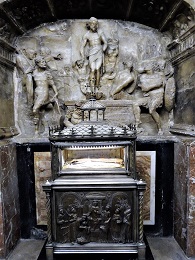 This contains an Alabaster high relief representing the Resurrection of Christ. At its foot is the incorrupt arm of Saint Vincent the Martyr, the Patron Saint of the city. 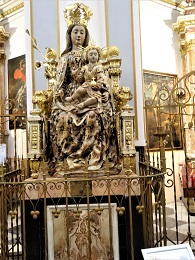 Just in front of the Chapel of the Resurrection is the statue of the Virgin of the Dignity. This was made in 1458 of alabaster stone which has been gilded and painted. The old Chapter House was constructed between 1356 -1369, with a beautiful vault with star motifs, depicting an image of heaven with the 12 apostles and the coronation of the Virgin Mary. This is now the Chapel of the Holy Grail, where since 1916 the Holy Chalice has been displayed and is one of the most popular attractions in the cathedral. 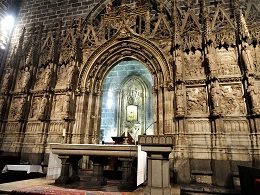 The chalice was given to the cathedral by King Alfons el Magnànim in 1436. Made from brown agate and dating back to the 1st century BCE, it is believed by some to be the Holy Grail. 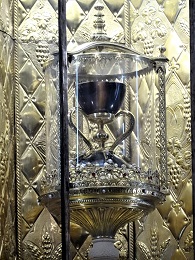 Standing about 6" tall and 3" wide it sits on a gold base adorned with two emeralds. This was created for it in the Middle Ages and is a major attraction. However, a number of other chalices exist, which also lay claim to being the chalice of Christ. The Holy Grail is said to be the cup of the Last Supper and, at the Crucifixion, was used to receive blood from the wound in Christ's side. Standing about 6" tall and 3" wide it sits on a gold base adorned with two emeralds. This was created for it in the Middle Ages and is a major attraction. However, a number of other chalices exist, which also lay claim to being the chalice of Christ. The Holy Grail is said to be the cup of the Last Supper and, at the Crucifixion, was used to receive blood from the wound in Christ's side.Although the authenticity of the Chalice has never been confirmed by the Vatican, it was used by Pope John Paul II during his visit in 1982 when he ordained some 150 priests. It was also used by Pope Benedict XVI in 2006 to consecrate the wine during the celebration of Mass. The cathedral has a number of chapels, one of which is dedicated to Saint Vincent Martyr, the Patron Saint of Valencia.  Saint Vincent Martyr was a Deacon under Saint Valerious, Bishop of Saragossa during the reign of the Roman Emperor Diocletian (284 - 305). Both were arrested and imprisoned, but whilst Saint Valerious was exiled, Saint Vincent Martyr was tortured and died from his injuries in 304. His left arm is preserved in a reliquary in his Chapel. The Chapel of St Peter the Apostle is located between the entrance and the Chapel of the Holy Grail. 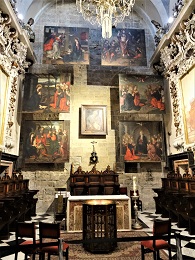 Built in the 15th century at one time it provided the access to the Chapter House. It was commissioned by Bishop Alfonso of Borgia in 1437 who was to become the first of the two Borgia Popes. It was damaged in 1936 but underwent restoration which was completed in 2013. Many of the chapels in the cathedral have been rededicated, one that has not is the Chapel of St James the Apostle. 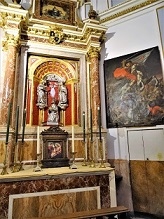 This contains a group of sculptures made of timber covered in silver in the 15th century showing St James kneeling before Christ with Mary standing behind. Also in the chapel are a number of tombs and also a reproduction of the first stone of the cathedral placed inside an arch of the 13th century. The Chapel of Saint Denys and Saint Margaret contains an important Altarpiece: this is painted in the archaic style which included the use of gold. 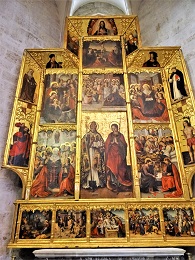 The Borgias were a prominent Spanish noble family who became prominent in the 15th and 16th centuries, producing two popes. St Francis Borgia was the great-grandson of Pope Alexander VI and was born in Valencia, he was canonised in 1670. Within the Chapel are two paintings by Goya. On the right of the altar is the exorcism which shows an exorcism being performed. 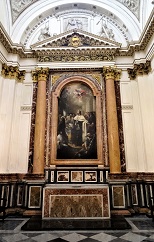 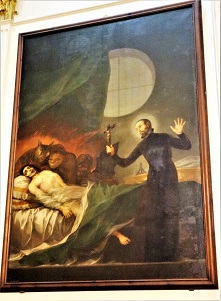 The cathedral contains numerous works of art both in the chapels and in the museum. The Cathedral Museum consists of a number of rooms displaying sacred relics and religious works of art from the 14th through the 18th Centuries, including a collection of medieval panels, vestments, and manuscripts. It also houses the statues that previously adorned the Apostle door. One of the most noticeable items is the Monstrance which is used to display a consecrated Host. During the Corpus Christi festival, it is carried through the streets of Valencia. 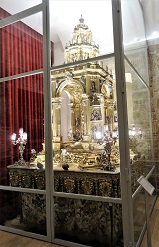 Over the years - during times of war - a number of the artifacts have been looted or destroyed. This included a silver altarpiece which in 1813 was melted down in order to pay the troops who fought against Napoleon. In 1931 the Spanish government declared the building a historic and artistic landmark. During the Spanish Civil War (1936-1939) it sustained some damage, which included decorative elements and the Organs, which were never rebuilt. In 1940 the choir was dismantled and moved from its position in the centre of the cathedral to the bottom of the High Altar. In the 1970s, a building attached to the chapels was demolished, as were a number of the neoclassical features to give the cathedral back its previous Gothic appearance. To see more photographs and take a virtual tour of the site click on the photoshow below.
|
|
|
|
|
|||
All Photographs were taken by and are copyright of Ron Gatepain
| Site Map |